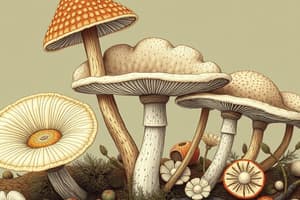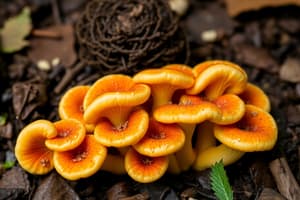Podcast
Questions and Answers
Which characteristic distinguishes fungi from bacteria?
Which characteristic distinguishes fungi from bacteria?
- Presence of sterols in the cell membrane. (correct)
- Presence of peptidoglycan in the cell wall.
- Absence of a nuclear membrane.
- Obligate anaerobic metabolism.
A fungal mycelium is described as macroscopic. What does this imply about the mycelium?
A fungal mycelium is described as macroscopic. What does this imply about the mycelium?
- It can be observed with the naked eye. (correct)
- It is only visible with the aid of a microscope.
- It is composed of prokaryotic cells.
- It lacks a defined cellular structure.
How does the nutritional strategy of fungi differ from that of protozoans?
How does the nutritional strategy of fungi differ from that of protozoans?
- Fungi acquire nutrients through photosynthesis, while protozoans rely on chemosynthesis.
- Fungi obtain food by ingestion, whereas protozoans absorb nutrients from their surroundings.
- Fungi synthesize their own food, while protozoans depend on external sources for nutrition.
- Fungi acquire nutrients through absorption, while protozoans obtain nutrients through ingestion. (correct)
Why are fungal spores significant beyond reproduction?
Why are fungal spores significant beyond reproduction?
Fungi are described as chemoheterotrophs. What does this classification indicate about their source of energy and carbon?
Fungi are described as chemoheterotrophs. What does this classification indicate about their source of energy and carbon?
How does the presence or absence of septa impact the structure of fungal hyphae?
How does the presence or absence of septa impact the structure of fungal hyphae?
How does the cell wall composition differ between fungi and bacteria, and what is the functional significance of this difference?
How does the cell wall composition differ between fungi and bacteria, and what is the functional significance of this difference?
What implications does fungal dimorphism have for pathogenicity, and how does it contribute to the organism's ability to cause disease?
What implications does fungal dimorphism have for pathogenicity, and how does it contribute to the organism's ability to cause disease?
Considering the structural components of fungal cells, which characteristic is most crucial for developing targeted antifungal therapies with minimal impact on human cells?
Considering the structural components of fungal cells, which characteristic is most crucial for developing targeted antifungal therapies with minimal impact on human cells?
How does the nutritional strategy of fungi as chemoheterotrophs influence their ecological role and interaction with other organisms?
How does the nutritional strategy of fungi as chemoheterotrophs influence their ecological role and interaction with other organisms?
In what way does the dimorphic nature of certain fungi affect their pathogenicity and ability to cause disease in humans?
In what way does the dimorphic nature of certain fungi affect their pathogenicity and ability to cause disease in humans?
How does the structural organization from cells to hyphae to mycelium contribute to the ecological success and adaptability of fungi in diverse environments?
How does the structural organization from cells to hyphae to mycelium contribute to the ecological success and adaptability of fungi in diverse environments?
Given that both fungi and arthropods contain chitin, why are antifungal drugs targeting chitin still effective and safe for use in humans?
Given that both fungi and arthropods contain chitin, why are antifungal drugs targeting chitin still effective and safe for use in humans?
Considering the classification of fungal infections, which category would a deep tissue infection resulting from a puncture wound by a contaminated thorn most likely fall under?
Considering the classification of fungal infections, which category would a deep tissue infection resulting from a puncture wound by a contaminated thorn most likely fall under?
How do the differences in cell structure between fungi and bacteria influence the strategies for developing effective antimicrobial treatments?
How do the differences in cell structure between fungi and bacteria influence the strategies for developing effective antimicrobial treatments?
Why is the ability of fungi to produce both sexual and asexual spores significant for their survival and adaptation in diverse environments?
Why is the ability of fungi to produce both sexual and asexual spores significant for their survival and adaptation in diverse environments?
How does the heterotrophic nature of fungi influence their interactions within an ecosystem?
How does the heterotrophic nature of fungi influence their interactions within an ecosystem?
How does the lack of peptidoglycan in fungal cell walls, compared to bacteria, inform treatments for fungal infections?
How does the lack of peptidoglycan in fungal cell walls, compared to bacteria, inform treatments for fungal infections?
If a new antifungal drug is developed to target fungal cell membranes, which component would offer the most selective target with the least risk to human cells?
If a new antifungal drug is developed to target fungal cell membranes, which component would offer the most selective target with the least risk to human cells?
If a patient is diagnosed with a systemic mycosis after organ transplantation, how does their immunocompromised state specifically contribute to the development and severity of this type of infection?
If a patient is diagnosed with a systemic mycosis after organ transplantation, how does their immunocompromised state specifically contribute to the development and severity of this type of infection?
In the context of fungal infections, what is the significance of distinguishing between cutaneous, subcutaneous, systemic, and opportunistic mycoses for diagnosis and treatment strategies?
In the context of fungal infections, what is the significance of distinguishing between cutaneous, subcutaneous, systemic, and opportunistic mycoses for diagnosis and treatment strategies?
How might understanding the structure of chitin and its role in fungal cell walls lead to the development of novel diagnostic tools for fungal infections?
How might understanding the structure of chitin and its role in fungal cell walls lead to the development of novel diagnostic tools for fungal infections?
How could a comprehensive understanding of fungal metabolism and nutrient acquisition pathways be exploited to develop new antifungal agents with improved specificity and reduced toxicity?
How could a comprehensive understanding of fungal metabolism and nutrient acquisition pathways be exploited to develop new antifungal agents with improved specificity and reduced toxicity?
Flashcards
What are fungi?
What are fungi?
Eukaryotic, non-photosynthetic organisms that obtain nutrients from other sources.
Mold vs. Yeast
Mold vs. Yeast
Multicellular fungi are called molds; unicellular forms are yeasts.
Fungal Cell Walls
Fungal Cell Walls
Fungal cell walls contain chitin, providing rigidity and protection.
What are Hyphae?
What are Hyphae?
Signup and view all the flashcards
What is Mycelium?
What is Mycelium?
Signup and view all the flashcards
Fungi vs. Bacteria (organelles)
Fungi vs. Bacteria (organelles)
Signup and view all the flashcards
Sterols in Fungi
Sterols in Fungi
Signup and view all the flashcards
Sexual vs. Asexual Spores
Sexual vs. Asexual Spores
Signup and view all the flashcards
Fungi
Fungi
Signup and view all the flashcards
Molds
Molds
Signup and view all the flashcards
Yeasts
Yeasts
Signup and view all the flashcards
Chitin
Chitin
Signup and view all the flashcards
Hyphae
Hyphae
Signup and view all the flashcards
Mycelium
Mycelium
Signup and view all the flashcards
Fungi vs. Bacteria (Size)
Fungi vs. Bacteria (Size)
Signup and view all the flashcards
Fungi vs. Bacteria (Cell Structure)
Fungi vs. Bacteria (Cell Structure)
Signup and view all the flashcards
Fungi vs. Bacteria (Cell Membrane)
Fungi vs. Bacteria (Cell Membrane)
Signup and view all the flashcards
Fungi vs. Bacteria (Cell Wall)
Fungi vs. Bacteria (Cell Wall)
Signup and view all the flashcards
Fungi Reproduction
Fungi Reproduction
Signup and view all the flashcards
Dimorphism
Dimorphism
Signup and view all the flashcards
Fungal Classification
Fungal Classification
Signup and view all the flashcards
Cutaneous Mycoses
Cutaneous Mycoses
Signup and view all the flashcards
Opportunistic Mycoses
Opportunistic Mycoses
Signup and view all the flashcards
Study Notes
- Fungi are eukaryotic and non-photosynthetic, functioning as heterotrophs
- Heterotrophs gain nutrients from phototrophs or other heterotrophs
- Non-photosynthetic organisms do not use sunlight to produce food
- Heterotrophic organisms cannot produce their own food and must get nutrients from other organic materials
- Fungi can be multicellular, referred to as molds, or unicellular, known as yeasts
- Fungal cell walls consist of chitin, unlike the peptidoglycan found in bacteria
Chitin Composition and Location
- Chitin is a strong polysaccharide composed of repeating N-acetylglucosamine units
- Chitin is found in fungal cell walls, providing structural support
Other Locations of Chitin
- Exoskeletons of arthropods, such as insects and crustaceans
- Mollusk radula and beaks, such as in squid and octopuses
Importance of Chitin in Fungi
- Gives fungal cell walls strength and rigidity, protecting against environmental stress
- Allows fungi to resist osmotic pressure, maintaining their shape
- Not found in human cells, making it a target for antifungal drugs
Fungal Filaments (Hyphae)
- Filaments are divided into compartments by cross-walls (septa), each containing a single nucleus
- Some fungi lack septa and are multinucleated
- The fungal body (mycelium) can be macroscopic or microscopic
Hyphae and Mycelium
- Hyphae are long, thread-like structures formed by fungal cells
- Mycelium is a network of hyphae, forming the "body" of the fungus
Differences Between Bacteria and Fungi
- Fungi are generally four times larger than bacteria
Cell Structure
- Fungi (eukaryotic) have a nuclear membrane and organelles like mitochondria and endoplasmic reticulum, which are absent in bacteria
Cell Membrane
- Fungal membranes contain sterols, whereas bacterial membranes have a phospholipid bilayer
Cell Wall
- Fungi contain chitin, while bacterial cell walls are made of peptidoglycan
Spores
- Fungi produce sexual spores for reproduction and asexual spores for survival
- Bacteria do not have this spore differentiation
Dimorphism
- Some fungi are dimorphic, existing in different forms (e.g., yeast and mold) depending on the environment, while bacteria are not
Metabolism
- Fungi require organic carbon and are not obligate intracellular pathogens
- Bacteria do not always need organic carbon and can survive in anaerobic conditions
Differences Between Fungi and Other Eukaryotes
- Fungi belong to the kingdom Fungi and are chemoheterotrophs
- Fungi are mostly multicellular, except for unicellular yeasts
- Fungi can be unicellular, filamentous, or fleshy, while protozoans are strictly unicellular
- Fungi acquire food by absorption, not diffusion or ingestion
- Fungi can contain both sexual and asexual spores, whereas other eukaryotes generally do not
Clinical Classification of Fungi
- Cutaneous mycoses affect the skin
- Subcutaneous mycoses affect subcutaneous tissue
- Systemic mycoses infect internal organs
- Opportunistic mycoses cause infections in immunocompromised individuals
Studying That Suits You
Use AI to generate personalized quizzes and flashcards to suit your learning preferences.




